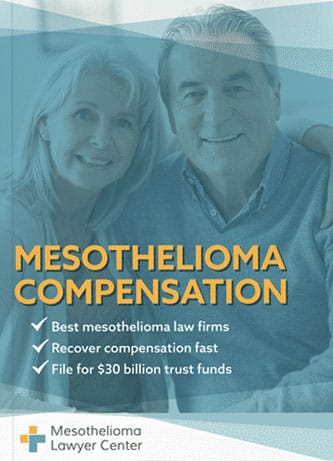El Curtis Bay Coast Guard Yard, now known as the United States Coast Guard Yard, is the U.S. Coast Guard’s primary shipbuilding and repair facility. The shipyard used large amounts of amianto in the past, exposing workers. Many civilian workers and veteranos later developed mesotelioma and other asbestos-related illnesses.
If you or a loved one have been diagnosed with mesothelioma, asbestos-related lung cancer, or asbestosis, you may be eligible for substantial compensation. There is currently over $30 billion in asbestos trust funds darse de víctimas de enfermedades relacionadas con el amianto. Complete nuestro formulario para recibir nuestro Paquete de Compensación Financiera gratuito. Nuestro paquete contiene información completa sobre abogados con experiencia en mesotelioma en su zona, cómo presentar una reclamación para fondos fiduciarios de asbesto, cómo recibir su compensación en 90 días y más.


Paquete de compensación financiera GRATUITO
- Información sobre despachos de abogados que recuperarán su INDEMNIZACIÓN MÁS ALTA
- Aprenda cómo cobrar en 90 días
- Solicite su parte de $30 mil millones en fondos fiduciarios

Did Curtis Bay Coast Guard Yard Use Asbestos?
Curtis Bay Coast Guard Yard used asbestos in its operations for several decades. Like other shipyards, Curtis Bay relied on asbestos to insulate and protect against fire on vessels.
Asbestos use in shipyards like Curtis Bay lasted from about the 1930s through the 1970s. By the 1970s, the harmful health effects of asbestos exposure were well known and government regulations came into effect.
Curtis Bay Coast Guard Yard History
The Curtis Bay Coast Guard Yard, established in 1899, began as both a boat repair facility and a training academy. By 1910, the shipyard began building vessels and continued to repair boats.
- These activities continued throughout World War II. The war brought about additional work for the shipyard, including buoy manufacturing and construction and complete vessel overhauls.
- World War II also brought a newly constructed 3,000-ton dry dock to Curtis Bay Shipyard, in addition to a new concrete pier and two new shipways.
- The shipyard was designated as the official U.S. Coast Guard Yard during this time. An estimated 3,100 civilian workers were employed at the shipyard during the war.
- As World War II ended, work ended for many employees as the shipyard focused on repairing vessels and building wooden boats. It also continued to overhaul old ships and create numerous larger vessels.
- Operations at Curtis Bay Coast Guard Yard slowed after WWII. Many people lost their jobs.
Today, the facility is called the U.S. Coast Guard Yard. It is the only shipbuilding facility serving the Coast Guard and continues to operate as a repair center. Approximately 1,300 people work there today.
How Was Asbestos Used at Curtis Bay Coast Guard Yard?
The use of amianto at Curtis Bay Coast Guard was typical of both civilian and military shipyards of the time. The military used more than 300 asbestos-containing products before the EPA regulated asbestos use.
Asbestos was known to have been used in the following at the Curtis Bay Coast Guard Yard:
- Electric wiring
- Electric equipment
- Pipes
- Pipe fittings
- Aislamiento
- Deck coatings
- Piso
- Engine and boiler rooms
Asbestos may have also been used in:
- Life boats
- Utility boats
- Response boats
- Port security boats
Asbestos was also in the pipes and insulation in buildings in the Coast Guard Yard. It could be found in equipment, machinery, and vehicles.
Who Was Exposed to Asbestos at the Curtis Bay Coast Guard Yard?
Both civilians and the men and women of the Coast Guard were affected by asbestos at the shipyard. Anyone who worked at Curtis Bay Coast Guard Yard was at risk of asbestos exposure and later illnesses.
Asbestos sheds tiny fibers that can be inhaled or ingested by anyone working with or around it. Workers who cut, manipulated, or handled asbestos materials had the highest risk of exposure. These included:
- Maintenance and repair workers
- Mecánica
- trabajadores de aislamiento
- trabajadores de calderas
- Instaladores de tuberías
- Steamfitters
- Soldadores
- electricistas
Curtis Bay Coast Guard Yard Superfund Site
The U.S. Environmental Protection Agency listed Curtis Bay Coast Guard Yard as a Superfund site in 2002. Both the Yard and the EPA contributed to the site’s cleanup, which was riddled with toxic substances like asbestos.
The official cleanup of Curtis Bay concluded in 2013. The EPA continues to monitor groundwater on the site. One area may need additional remediation.
Curtis Bay Coast Guard Yard Asbestos Lawsuits
Many workers who developed asbestos-related illnesses filed asbestos-related lawsuits against the manufacturers that provided the products to the shipyard.
One such asbestos manufacturer, Owens-Illinois Glass, faced a lawsuit from the family of Harry Hunter, a man who once worked at the Curtis Bay Coast Guard Yard in the summer of 1956. He was an electrician and worked regularly with and around asbestos materials.
Hunter died of malignant mesothelioma in 2001, but his family carried out the lawsuit and eventually won $4.2 million for Hunter’s wrongful death.
Unfortunately, since the lawsuit was filed in Maryland, state laws prevented the family from getting the total amount, and it was subsequently reduced to $2.6 million.
How Can Curtis Bay Asbestos Victims Get Compensation?
Both veterans and civilians with an asbestos illness can sue the asbestos companies that supplied the Coast Guard. Mesothelioma lawsuits often result in substantial asentamientos Para las víctimas.
Former Curtis Bay workers with mesothelioma may also qualify for compensation claims with fondos fiduciarios de amianto. These are funds set up by asbestos companies that filed for bankruptcy because of lawsuits.
Veterans who served at Curtis Bay may qualify for benefits through the U.S. Department of Veterans Affairs (Virginia). VA benefits include disability payments, compensation for dependants, and specialist medical care.
If you worked at Curtis Bay and now have an asbestos illness, contact an experienced lawyer for advice. You have legal options for seeking compensation.
Additional Help and Resources for Asbestos Victims
If you’ve been injured by mesothelioma, asbestos-related lung cancer, or asbestosis, keep in mind that there is a good chance that you’ll qualify for considerable compensation. Remember to fill out our form to get your free Financial Compensation Packet, with information on experienced asbestos and mesothelioma lawyers in your area.

Pablo Danziger
Revisor y editorPaul Danziger creció en Houston, Texas, y se licenció en Derecho en la Facultad de Derecho de la Universidad Northwestern en Chicago. Durante más de 25 años, se ha dedicado a representar a víctimas de mesotelioma y a otras personas afectadas por la exposición al asbesto. Paul y su bufete han representado a miles de personas diagnosticadas con mesotelioma, asbestosis y cáncer de pulmón, obteniendo indemnizaciones significativas para los clientes lesionados. Cada cliente es fundamental para Paul y atenderá todas las llamadas de quienes deseen hablar con él. Paul y su bufete se encargan de casos de mesotelioma en todo Estados Unidos.
Conéctese con el abogado especializado en mesotelioma Paul Danziger
Referencias
- Agency for Toxic Substances and Disease Registry. (n.d.). PUblic Health Assessment. Curtis Bay Coast Guard Yard.
Recuperado de: http://www.atsdr.cdc.gov/HAC/pha/CurtisBay121504/CurtisBay-pt1.pdf - The Baltimore Sun. (2003, April, 4). Jury Awards $2.6 Million in Asbestos Case.
Recuperado de: https://www.baltimoresun.com/news/bs-xpm-2003-04-04-0304040362-story.html - U.S. Environmental Protection Agency. (n.d.). Superfund Site: Curtis Bay Coast Guard Yard Baltimore, MD. Cleanup Activities.
Recuperado de: https://cumulis.epa.gov/supercpad/SiteProfiles/index.cfm?fuseaction=second.Cleanup&id=0304341#bkground
